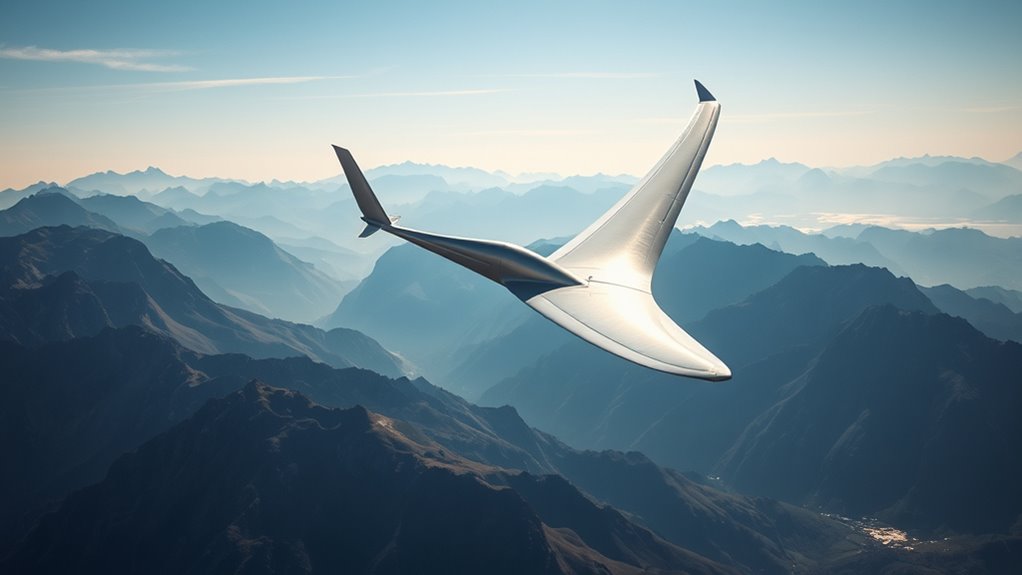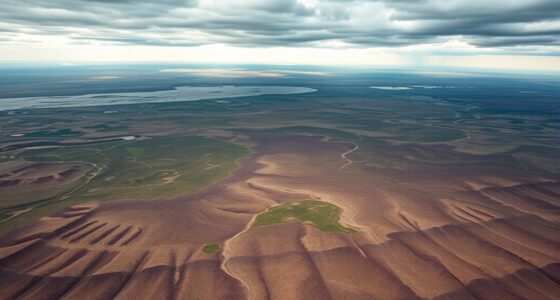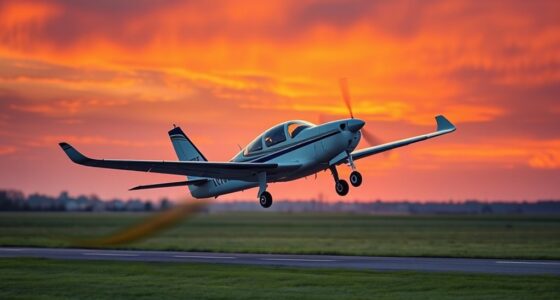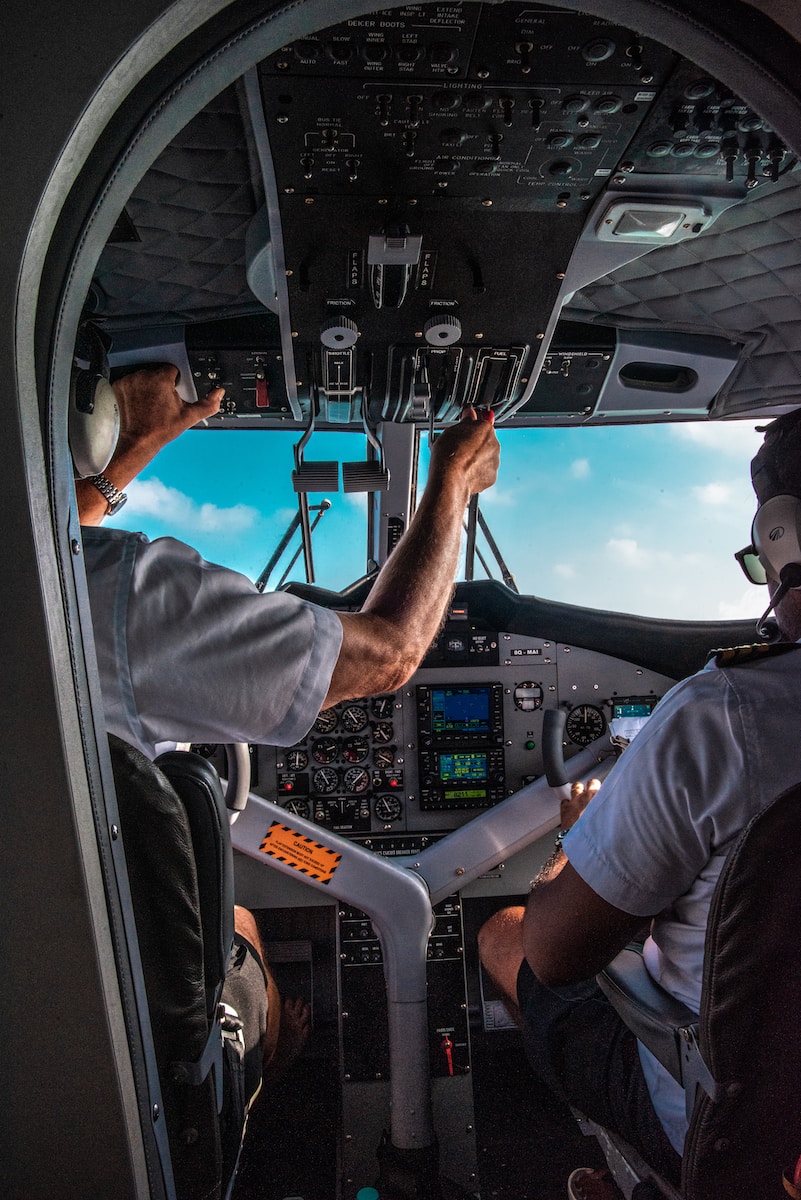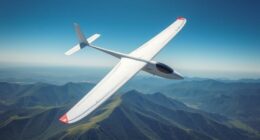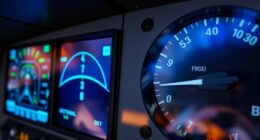Dynamic soaring lets you borrow speed from the wind by crossing air masses with different wind speeds and directions. Birds and drones exploit atmospheric layers, riding thermals, wind shear, and updrafts to gain altitude and boost speed. This energy-efficient technique relies on understanding wind patterns and gradients. By mastering this, you can improve flight performance and efficiency. If you want to explore how nature’s flight tricks can inspire new technologies, keep going to uncover more.
Key Takeaways
- Dynamic soaring involves crossing wind speed gradients to gain kinetic energy without flapping.
- Birds exploit atmospheric shear zones to repeatedly extract energy from wind currents.
- Recognizing wind layer variations allows efficient harnessing of wind for increased flight speed.
- Turbulence near shear zones can be destabilizing but also provide lift opportunities for speed gain.
- Mimicking natural soaring techniques can inform the design of energy-efficient flying and autonomous systems.
The Basics of Dynamic Soaring

Dynamic soaring is a method birds and gliders use to gain energy by repeatedly crossing the boundary between air masses with different wind speeds. You’ll notice that many migratory birds rely on this technique to travel long distances efficiently, conserving energy during their journeys. By riding the wind’s currents, they can cover vast areas without flapping their wings constantly. This movement also helps in predator avoidance, as soaring high makes it harder for predators to catch them. When birds exploit these wind gradients, they extend their flight range and stay more alert to threats. Understanding the basics of dynamic soaring reveals how nature’s design helps birds optimize energy use and improve survival during migration and in predator-rich environments.
How Birds Master the Technique

Birds master the technique of dynamic soaring through a combination of instinct, experience, and keen environmental awareness. They exploit atmospheric features like wingtip vortices created by other flying objects, which generate upward-moving air currents. To do this effectively, birds rely on feather adaptations that optimize lift and minimize drag, such as stiff, contour feathers that streamline their bodies. Their keen eyesight helps them identify the best soaring paths and detect subtle changes in wind patterns. By timing their movements precisely, they use the wind’s energy to gain speed and altitude without flapping much. This mastery allows them to conserve energy while covering vast distances, turning the wind’s power into a reliable source of propulsion. Their skills are a perfect blend of biological evolution and environmental understanding. Additionally, their ability to cost and budgeting enables them to efficiently utilize available resources during long migrations.
Atmospheric Conditions That Enable Soaring

The atmospheric conditions that make soaring possible hinge on specific wind patterns and temperature differences. You need the right cloud cover, often forming along temperature gradients, which create rising warm air or thermals. These thermals are essential for gaining altitude without flapping or engine power. Clear skies with scattered clouds indicate strong temperature gradients, where warm ground air rises rapidly, producing lift. Conversely, overcast skies may suppress thermal formation, limiting soaring opportunities. Strong, consistent wind shear and specific wind directions also play a role by providing dynamic lift, especially in coastal or mountainous regions. By understanding how these cloud cover patterns and temperature gradients interact, you can identify optimal soaring conditions and harness the environment’s natural energy to stay aloft longer. Additionally, aerodynamic stability influences how effectively a glider can utilize these atmospheric features for sustained flight.
The Physics Behind Speed Extraction
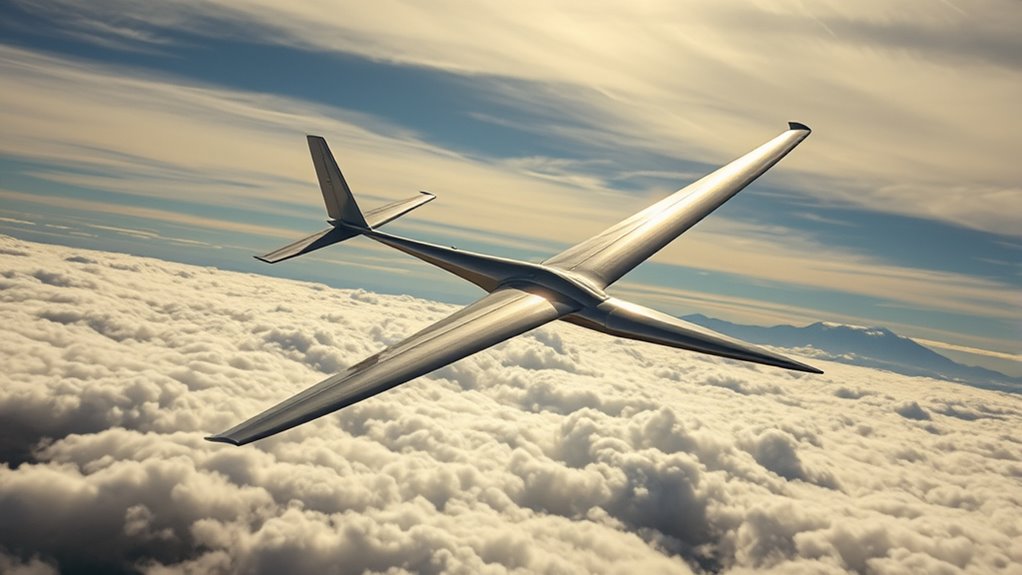
To understand how birds achieve incredible speeds, you need to look at the balance between lift and drag. This balance allows them to maximize energy transfer from the environment into motion. By analyzing these forces, you can grasp how speed is extracted efficiently during dynamic soaring. Additionally, understanding the role of airflow patterns can provide deeper insight into how birds optimize their flight paths for maximum speed.
Lift and Drag Balance
Understanding how lift and drag interact is essential for grasping the physics behind a soaring bird’s speed. As you glide, your lift coefficient determines how much lift you generate for a given angle of attack, while the drag force opposes your forward motion. To maximize speed, you aim to balance these forces: lift must support your weight without creating excess drag. The table below illustrates the relationship:
| Force Type | Role in Speed Extraction |
|---|---|
| Lift coefficient | Affects how efficiently you generate lift at different angles |
| Drag force | Opposes forward motion, depends on shape and angle of attack |
Maintaining this balance allows you to harness wind currents effectively, optimizing your speed through the right lift-to-drag ratio. Additionally, airfoil shape plays a crucial role in determining how lift and drag are generated, impacting overall flight efficiency.
Energy Transfer Mechanics
Maximizing your speed while soaring depends on how effectively you transfer energy from the surrounding air currents into your flight path. This involves understanding the physics of energy transfer, particularly through turbulence modeling and wind shear analysis. As you exploit the wind’s energy, you harness the differences in airspeed and direction to gain momentum. By analyzing wind shear, you identify zones where energy transfer is most efficient, allowing you to adjust your flight path accordingly. Turbulence modeling helps predict airflow patterns, making your energy exchanges more predictable. This combination allows you to optimize your trajectory, extracting maximum speed from the wind. Effective energy transfer depends on timing and positioning.
Comparing Natural and Mechanical Flyers
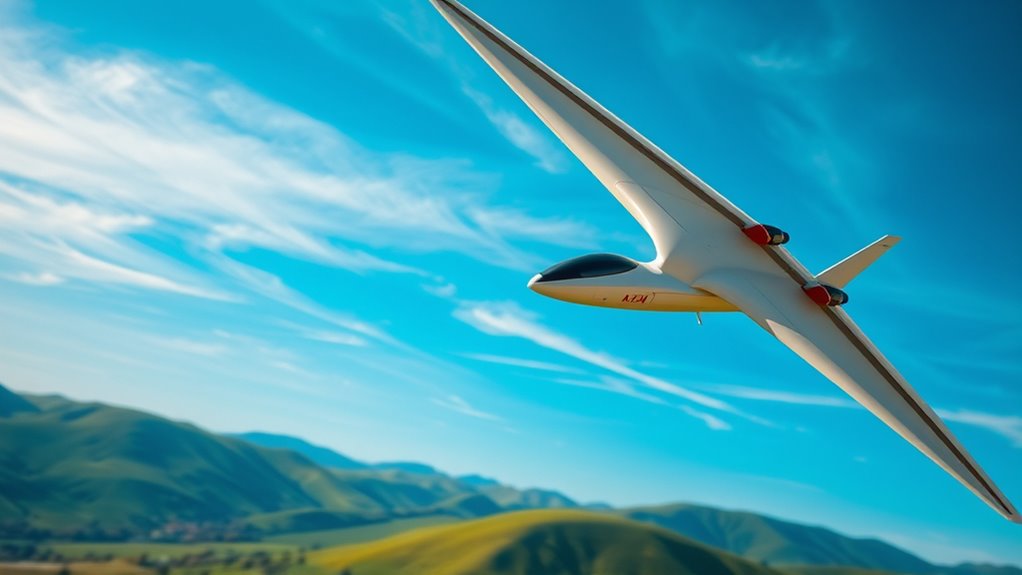
Natural flyers like birds and insects have evolved highly efficient methods of dynamic soaring, using their bodies to exploit wind currents and energy in the environment. During bird migration, they harness wind patterns to conserve energy over long distances, gliding along updrafts and tailwinds. Their wings are designed for optimal lift and maneuverability, allowing them to adapt seamlessly to changing conditions. Mechanical flyers, such as drones and gliders, mimic these strategies but rely on engineered systems like sensors and motors to detect and exploit wind flows. While natural flyers depend on instinct and biological adaptations, mechanical flyers use technology to replicate these behaviors, often with greater control and consistency. Understanding biological adaptations provides valuable insights that inform the design of more efficient human-made flying systems, demonstrating how nature’s solutions inspire and improve engineering.
The Role of Wind Layers and Shear Zones

You’ll find that wind layers can vary markedly in strength and direction, impacting your soaring strategy. Shear zones create sharp changes in wind speed and flow, which can be harnessed to gain altitude. Understanding the altitude wind profiles helps you predict these patterns and optimize your path through different wind conditions. Recognizing family influences and cultural heritage can also inform your understanding of environmental factors affecting soaring environments.
Wind Layer Variability
Have you ever wondered how changing wind layers and shear zones influence the soaring process? Layer variability affects how you can maximize energy from the wind. As you navigate different altitudes, wind shear creates zones where wind speed and direction shift abruptly, impacting your lift and speed. Recognizing these wind layer variations helps you choose ideal flight paths. You might encounter:
- Sudden shifts in wind direction at different altitudes
- Variations in wind speed between layers
- Sharp shear zones that can destabilize your flight
- Gradual changes offering smooth lift opportunities
- Turbulence near shear zones disrupting stability
Understanding these wind layer dynamics allows you to adapt your technique, borrowing energy efficiently from the environment without losing control. Mastering layer variability is key to mastering dynamic soaring. Creativity in your approach can lead to innovative strategies for navigating complex wind conditions.
Shear Zone Dynamics
Understanding how wind layers interact is vital when traversing shear zones. Shear zone interactions occur where different wind speeds and directions meet, creating sharp gradients. These zones can cause turbulence effects that challenge even experienced soaring pilots. As you cross a shear zone, sudden changes in wind velocity can disrupt your flight path or increase drag, requiring quick adjustments. Recognizing these zones allows you to exploit them for lift or avoid hazardous turbulence. The turbulence effects within shear zones are often unpredictable, demanding constant vigilance and precise control. By understanding shear zone dynamics, you can better anticipate wind behavior, improve your energy management, and maintain stability. The presence of turbulence within shear zones highlights the importance of understanding how wind layers behave. Mastering how shear zones function is essential to harnessing wind layers effectively for dynamic soaring.
Altitude Wind Profiles
Altitude wind profiles describe how wind speed and direction vary with height, forming the foundation for effective dynamic soaring. Recognizing these layers helps you identify ideal zones for gaining energy from the wind. Wind shear, a rapid change in wind speed or direction over a short vertical distance, can be a key factor in energy extraction. Atmospheric variability causes these profiles to shift frequently, requiring quick adaptation. Visualize:
- Sharp wind speed increases with altitude
- Direction shifts indicating shear zones
- Layers of still air beneath strong winds
- Turbulence near jet streams
- Variability during different weather conditions
Understanding these elements allows you to exploit wind layers efficiently, maximizing your soaring potential while minimizing risks posed by wind shear and atmospheric variability. Recognizing wind shear can help you anticipate sudden changes and adapt your flight path accordingly.
Energy Efficiency in Long-Distance Travel
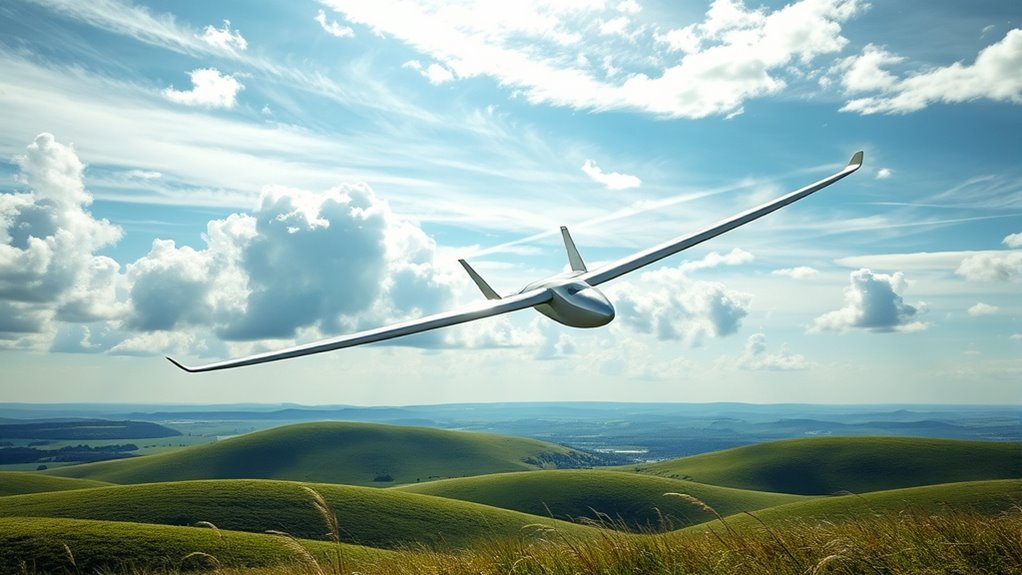
Ever wondered how long-distance travel can become more energy-efficient? Bird migration offers a perfect example. Birds optimize their flight paths to conserve energy, riding wind currents and soaring with minimal effort. This natural strategy becomes even more essential as climate change alters wind patterns and migratory routes. By studying these behaviors, we can develop ways to reduce fuel consumption in airplanes and ships, making travel more sustainable. Using atmospheric conditions to our advantage allows us to borrow speed from the wind, decreasing reliance on engine power. Emulating bird migration techniques helps improve efficiency and cut emissions. As we face climate challenges, adopting these natural lessons becomes crucial for fostering eco-friendly long-distance travel solutions.
Innovations in Glider Design Inspired by Nature
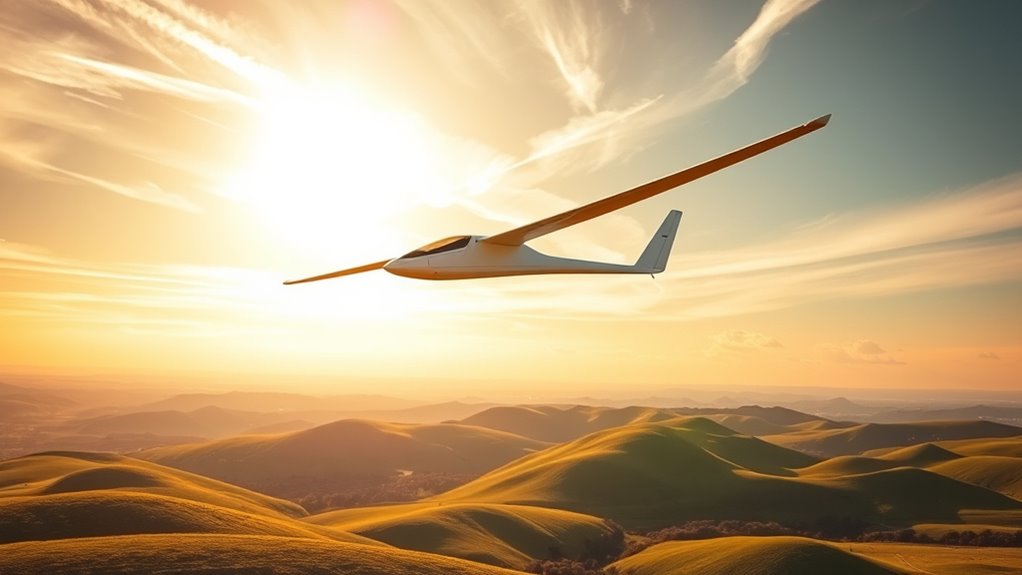
Nature has long been a source of inspiration for designing more efficient gliders, as birds masterfully optimize their wing shapes and flight strategies to minimize energy use. You can see this influence in the development of biomimetic wings, which mimic bird wings for better lift and maneuverability. Aerodynamic innovations drawn from nature have led to sleeker, more adaptable glider designs. These include flexible wing structures that adjust during flight, inspired by bird wing morphology, and wingtip designs that reduce drag, inspired by bird flight paths. Additionally, lightweight materials echo the lightweight bones of birds, enhancing performance. These innovations allow gliders to better harness wind currents, improve stability, and extend flight duration, all by borrowing the natural efficiency perfected over millions of years of evolution.
Challenges and Limitations of Dynamic Soaring
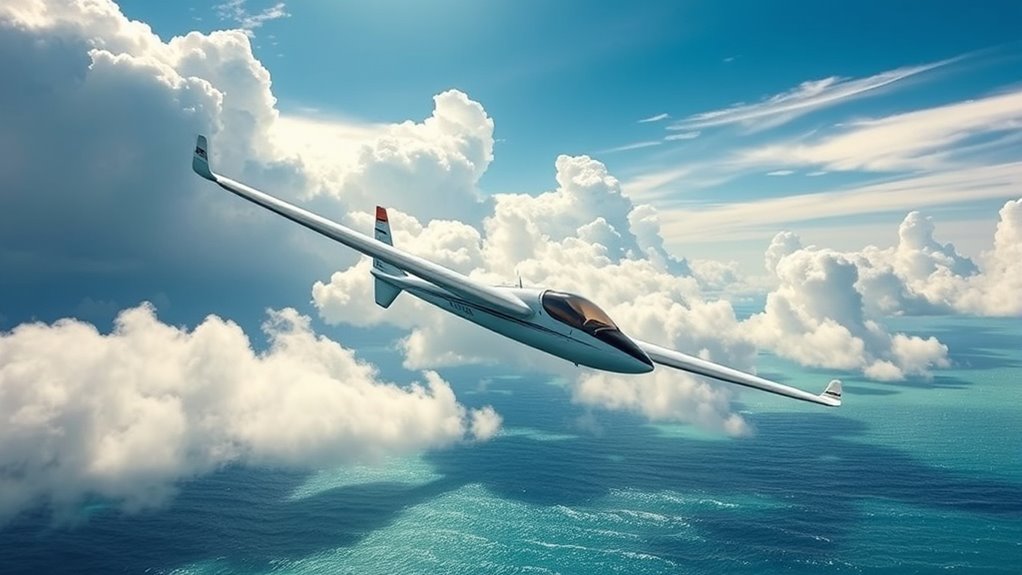
What makes dynamic soaring a challenging technique is its strict environmental and aerodynamic requirements. You need smooth, consistent wind gradients, which are rare in nature. Turbulence effects can disrupt your flight path, making it harder to maintain the precise maneuvers needed to extract energy from the wind. Weather unpredictability adds another layer of difficulty; sudden changes in wind speed or direction can force you to abort the maneuver or risk losing altitude. Additionally, these conditions demand exceptional skill and real-time adjustments, limiting when and where you can practice effectively. Because of these constraints, dynamic soaring remains a niche technique—powerful but highly sensitive to environmental factors beyond your control. Overcoming these challenges requires careful planning and a deep understanding of atmospheric dynamics.
Future Developments and Potential Applications
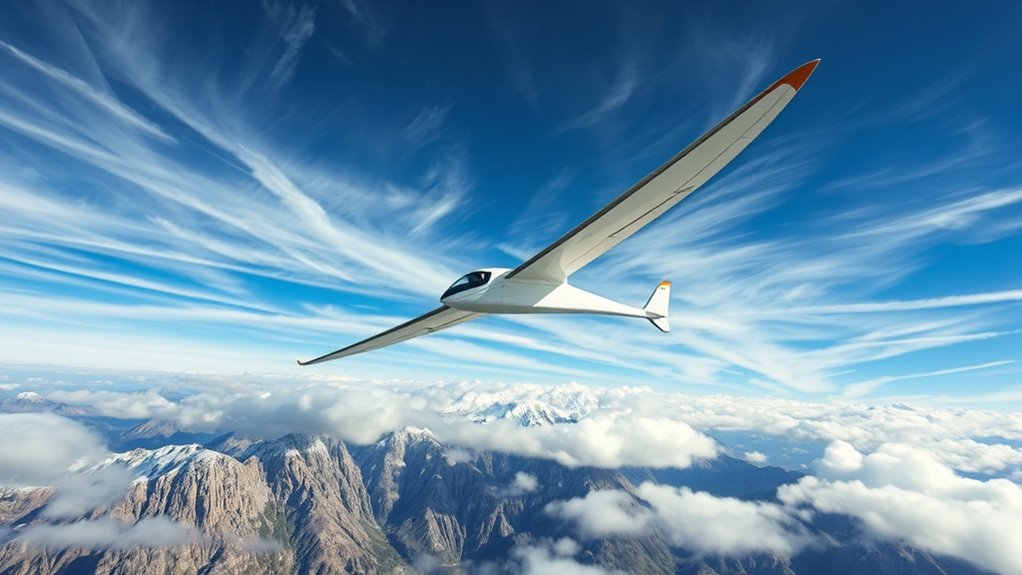
Future advancements in dynamic soaring could markedly boost energy efficiency and reduce reliance on traditional power sources. You might see this technique integrated with renewable energy systems, enhancing sustainability. Additionally, it holds promise for powering advanced autonomous vehicles, opening new possibilities for transportation and exploration.
Enhanced Energy Efficiency
How might advancements in dynamic soaring technology lead to significant improvements in energy efficiency? By harnessing wind patterns more effectively, you could reduce reliance on traditional energy sources, especially in urban environments. This method can optimize the use of solar energy and urban wind, making energy collection more sustainable. As technology advances, expect to see smarter control systems that adapt to changing wind conditions, maximizing efficiency. Imagine drones or autonomous aircraft efficiently capturing wind energy at high altitudes, then converting it into usable power with minimal loss. Enhanced energy efficiency might also lower costs, expand renewable energy applications, and support grid stability. This progress could revolutionize how cities utilize wind, turning urban wind into a reliable energy resource that complements solar power.
Renewable Power Integration
Advancements in dynamic soaring technology open new avenues for integrating renewable power sources into existing energy systems. You can now explore innovative ways to enhance solar panel and wind turbine efficiency by leveraging wind patterns and energy harvesting techniques inspired by soaring birds. Dynamic soaring allows wind turbines to capture more consistent and stronger winds at higher altitudes, increasing energy output. Similarly, solar panels can be positioned strategically to optimize exposure by understanding airflow and wind dynamics. These developments enable more reliable and sustainable power generation, reducing dependence on fossil fuels. As technology improves, you’ll see smarter integration of renewable sources, making energy grids more flexible. This progress promises a future where renewable energy is more efficient, accessible, and capable of meeting increasing global demands.
Advanced Autonomous Systems
As autonomous systems become more sophisticated, their potential to transform industries and daily life grows considerably. You’ll see biomimicry innovation driving new designs inspired by nature, especially in wind energy applications. These systems can optimize energy harvesting, improve safety, and reduce costs. Future developments include self-learning drones maneuvering complex environments and autonomous turbines adjusting in real time for maximum efficiency. Imagine wind farms with blades mimicking bird flight patterns to enhance energy capture or autonomous vehicles coordinating seamlessly in traffic. You might also encounter AI-powered robots performing maintenance in hazardous locations. These advancements will enable smarter, more adaptable solutions that harness wind energy more effectively, reducing reliance on fossil fuels. The integration of advanced autonomous systems will revolutionize how we generate, distribute, and utilize renewable energy sources.
Frequently Asked Questions
How Do Birds Instinctively Locate Optimal Wind Zones for Soaring?
You might wonder how birds instinctively find the best wind zones for soaring. Their remarkable bird navigation relies on keen wind detection, allowing them to sense subtle air currents and pressure changes. They instinctively monitor wind patterns, adjusting their flight to catch rising thermals or glide efficiently. By interpreting these environmental cues, birds maximize their energy, effortlessly harnessing the wind to soar higher and travel farther.
Can Dynamic Soaring Be Effectively Simulated With Current Drone Technology?
You’re asking if current drone tech can effectively simulate dynamic soaring. While it’s a tall order, advances in aerial navigation and wind pattern analysis are making it possible. Drones can now mimic soaring behaviors by analyzing wind currents and adjusting their flight paths. Although real-world conditions are complex, ongoing research is closing the gap, proving that with enough data, you can teach drones to borrow speed from the wind just like birds do.
What Are the Environmental Impacts of Large-Scale Dynamic Soaring Operations?
You wonder about the environmental impacts of large-scale dynamic soaring. When you deploy these operations widely, expect an increased environmental footprint, especially if they disturb local wildlife. The high energy use and noise can disrupt habitats and animal behaviors. To minimize harm, you should carefully plan flight paths, limit noise pollution, and monitor wildlife reactions, ensuring these advanced flying techniques don’t negatively affect ecosystems.
How Do Atmospheric Disturbances Affect the Stability of Dynamic Soaring?
Did you know that 90% of flight delays are caused by atmospheric turbulence? Atmospheric disturbances like turbulence and wind shear can markedly impact your stability during dynamic soaring. These conditions cause unpredictable changes in wind speed and direction, making it harder to maintain a smooth, efficient glide. When wind shear occurs, your craft may experience sudden shifts, risking loss of control and reducing the effectiveness of borrowing energy from the wind.
Are There Specific Geographic Regions Ideal for Implementing Dynamic Soaring Techniques?
You should look for geographic hotspots and wind corridors, as they offer ideal conditions for dynamic soaring. These regions have consistent, strong winds that enable you to efficiently borrow speed from the wind. By focusing on areas with predictable airflow, you’ll maximize your ability to harness energy and maintain stability. Such locations are perfect for practicing or optimizing dynamic soaring techniques, making your flights more efficient and longer.
Conclusion
By understanding how birds harness the wind through dynamic soaring, you can appreciate nature’s ingenuity. This technique shows that “where there’s a will, there’s a way,” even in the skies. As technology advances, mimicking these natural strategies could revolutionize flight efficiency and sustainability. Keep exploring and innovating, because the sky’s the limit when you learn from the masters of the air. Embrace nature’s lessons—sometimes, the simplest ideas soar the highest.
